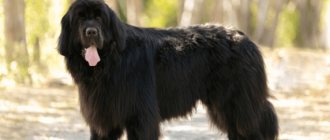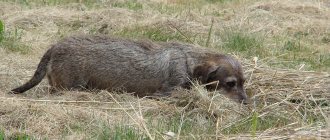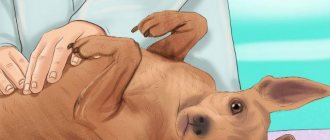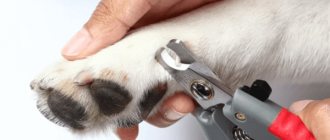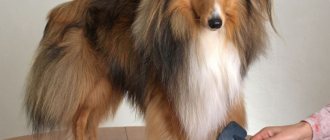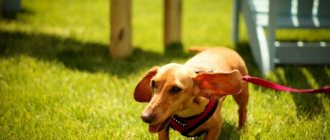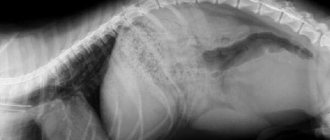Dachshund puppies belong to the hunting breed and in ancient times were favorites of the royal court due to their high intelligence. By nature, the dachshund is smart, sociable and inquisitive, and is classified as sanguine. The main feature is the hunting instinct and loud barking, which scares away intruders if they want to get into someone else's house. A dachshund puppy can please any owner. But in order for an animal to please its owner for many years and bring only positive emotions, you need to know the distinctive features of this breed.
Dachshund puppies belong to the hunting breed and in ancient times were favorites of the royal court due to their high intelligence
Features of the first days of life
Dachshund puppies receive maximum care and attention from their mother from birth. The dog diligently licks, pushes, and turns them over. Its task is to activate intestinal and lung functions in children. Puppies are born blind and deaf, but they feel cold, pain, and touch. All they need in the first days is milk and warmth. Having eaten, a healthy baby quickly falls asleep.
The sucking instinct of newborn dachshund puppies is highly developed, so it is difficult to tear them away from their mother’s breast.
It is important for the owner of this breed of dog to ensure that all puppies receive enough food. Various noises and chewing of the nipple mean that there is no milk in it and the dog needs to be helped to find another one. The fullest nipples in bitches are the rear ones. Weak babies should be supported with your hand when feeding. 2-3 days after birth they begin to crawl and control their balance.
Required air temperature
Newborn dachshund puppies lack self-regulation of body temperature. Therefore, you need to make sure that it is at least 24 degrees Celsius where the dogs are. The first week of a dachshund's life is filled with sleeping and sucking milk. Left alone, the cub easily freezes.
Interesting article: Rules for caring for a dachshund
The normal temperature of small puppies is 35-37 degrees. After 2-3 weeks it reaches 36-37.5. In another 10-14 days it will be like that of an adult dog - 37-38.5.
Expert opinion
Anna Abramenko
An avid dog lover. Experience in veterinary medicine since 2009.
Ask a Question
To measure the body temperature of puppies, use a regular rectal thermometer.
Development
Standard dachshund cubs grow quickly and get stronger. 2 weeks after birth, dogs can already suck from a bottle and behave calmly when they are picked up. They are even capable of growling at the offender from among their brothers and sisters.
Between the second and third week, babies develop hearing. This is the time when they begin to eat solid food, stand confidently on their paws, and play. At the fourth week, dogs erupt their first teeth - the upper canines. Month-old dachshund puppies are curious and eager to explore the world. They are no longer afraid to leave their mother, they explore the territory, and try to chew on objects.
Six-month-old puppies become similar to adult dogs. At this stage, the dachshund may try to become the master of the house. But you shouldn’t allow your dog too much. Mistakes made by the owner can lead to problems with small dachshunds.
Baby teeth and cleaning
Baby teeth appear at three weeks of age. They are sharper than permanent and very fragile. Baby teeth grow completely by 5-6 weeks.
It is not always possible to judge by the bite of baby teeth what a dog's bite will be like . You need to carefully monitor the change of your puppy's teeth, since baby teeth that do not fall out in time can cause the formation of a malocclusion.
To prevent this from happening, you need to give the puppy something hard to chew on, like a carrot. Sometimes a loose baby tooth cannot fall out (especially baby canines) and interferes with the proper growth of permanent teeth.
In this case, they have to be removed. Playing with a puppy with a strong, but not dense rag can help in this matter; this will be the most painless way to remove a “stagnant” tooth .
Permanent teeth begin to replace baby teeth at 12-16 weeks. The process of changing teeth can be very painful for puppies.
The dog is taught to brush its teeth from the age of two months. First, use your own finger, wrapped in several layers of bandage. Apply paste to the bandage and wipe the outside of the teeth.
In the future, you can try using a baby brush . The procedure takes no more than 10 minutes. If the puppy endures the test, he should be rewarded.
Care and care
From birth to adulthood, puppies need to be monitored and monitored for their health. The first weeks of a dachshund's life are dangerous due to the appearance of infections. A common cause of death in puppies at this age is E. coli. A sick puppy screams incessantly, continuously crawls on the bedding, and passes loose stool. In this case, he needs immediate veterinary attention.
Expert opinion
Anna Abramenko
An avid dog lover. Experience in veterinary medicine since 2009.
Ask a Question
When a puppy is infected with E. coli, it is often fatal. It is necessary to separate the dog from the rest of the litter and provide him with qualified assistance.
Growing dachshunds' nails grow quickly. While feeding, the puppies rest their paws on the bitch's stomach, press around the nipple, and injure the skin. This causes pain to the dog, which may cause him to avoid feeding the next time. Therefore, puppies need to have their nails trimmed every week until they are one month old. Then this procedure is repeated every 10 days while the mother feeds the dogs. You only need to shorten the tips of the claws without touching the soft tissues.
This is interesting: What to name a dachshund puppy
A two-week-old dachshund puppy's eyes open. A gap appears on the side of the bridge of the nose and gradually increases until it opens completely. At this stage, puppies begin to distinguish objects. Vision becomes normal at 5 weeks. The owner of the dachshund should examine the dog and wash its eyes if an infection begins.
Interesting article: Dachshund price: how much does a Dachshund puppy cost in Russia
Along with vision, dachshunds develop hearing. Wax builds up in your dog's ear canals, causing a blockage. You need to clean them, pull out the hairs there from long-haired dachshunds.
Expert opinion
Anna Abramenko
An avid dog lover. Experience in veterinary medicine since 2009.
Ask a Question
Regardless of breed, puppies must be dewormed. The first time it is done at the age of 5-6 weeks, repeated with an interval of 10 days. Before using antihelminthic drugs, you need to read the instructions to calculate the correct dosage. Taking medication incorrectly can lead to the death of your dog.
How it develops from 1 to 12 months
| Puppy age | Stages of development |
| 1 month | The two main activities are eating and sleeping. Puppies grow quickly, gain weight, and recognize bright objects. From two weeks of age they can move independently |
| 2 month | Teeth appear, it is possible and even beneficial to give something solid as food, something that can be chewed, for example, a carrot. The active development of living space begins. Puppies need supervision. |
| 3 month | Character is formed. The first walks begin. The puppy tries to walk on a leash, gets the basics of training |
| 4 month | Awareness of one’s “social” role, one’s place in the “pack.” The first attempts to demonstrate a leadership character. |
| 4-8 month | The puppy may run away from its owner |
| 5-6 month | Walking increases |
| 6-10 month | Puberty begins. The bitch is in her first heat, and the males are marking their territory. |
| 8-9 month | All permanent teeth grow, relationships of subordination and leadership are consolidated |
Nutrition
Small dachshund puppies are initially completely dependent on the bitch. She gives milk and care. The owner needs to provide the dog with adequate nutrition to maintain strength. The dachshund must be walked, cleaned, and there must be a dish of water next to it.
Puppies mostly sleep when they have enough milk. If small dachshunds show restlessness, squeak, look for nipples, and do not experience daily weight gain, then perhaps they simply do not have enough food. Then the dogs begin to be given complementary foods. If you do this early, the bitch will lose milk prematurely; if it is done too late, the puppies may experience growth retardation.
Dachshund puppies suck less milk when given food from outside. This is a signal for the bitch to stop producing it. It is necessary to try to prolong the feeding of babies from the mother. No complementary food can compare with her milk in composition and benefits.
Dachshund puppies that have not gained weight for several days are given cow's milk and eggs in their diet. From three weeks of age, dogs can be given semi-liquid milk porridge. They are cooked from cereals crushed with a blender or meat grinder, mainly oatmeal, buckwheat, and semolina. Dachshunds are given porridge twice a day, gradually moving to 4 feedings a day. Later, fresh lean minced meat, preferably beef or horse meat, is added to the puppies’ diet. After this, dogs can be given finely chopped raw meat, but no more than 35-40 g daily. The dachshund's portion should be increased periodically and be about 100 g by the age of 1 month. For older dogs, vegetable soups are cooked in broth with finely chopped meat and cereals. Complementary foods are given at regular intervals, alternating them.
Suitable for puppies without mother's milk:
- meat;
- vegetables;
- fish;
- concentrated factory feed;
- porridge;
- dairy products.
Meat is the most valuable food for dogs. In its raw form it should be 1/3 of the daily requirement. The animal needs to receive it at least three to four times a week, and preferably every day. Sometimes pure meat for dachshunds is replaced with offal (stomach, liver), pre-boiled, and sea fish. This can be done no more than two or three times a week.
For adequate nutrition, dogs add calcium, bone meal, fish oil, and finely chopped vegetables to their food as mineral and vitamin supplements. Kefir, cottage cheese and other milk products are not contraindicated for puppies.
Expert opinion
Anna Abramenko
An avid dog lover. Experience in veterinary medicine since 2009.
Ask a Question
Recently, various feeds made in factories have been widely used - canned food, granules. They contain the necessary substances for dogs and are easy to use. They are added to the diet, alternating with soup made from fresh ingredients.
Dachshunds with baby teeth can be given raw beef bones.
Training and temperament
Dachshunds have a complex, sometimes capricious character. It is not so easy to teach this dog to follow the rules, but this is not due to his lack of intelligence. On the contrary, the dachshund has an innate sense of self-esteem, intelligence, pride, and independence that do not allow them to obey.
The future owner of a dachshund should expect that his pet can be spontaneous and unpredictable. A dog can be taught to follow commands, but sometimes it prefers to live by its own rules.
They begin to raise a dachshund from the moment they are weaned from their mother. Dog breeders note that the best age for a dog to do this is 2 months.
You need great patience and respect for the dog for it to become a good friend and protector. A sequence of actions, a reward system, and calm handling are a necessity when training puppies. When teaching the rules of behavior, life in a family, an apartment, you should not hit or shout at your pet. This can result in reverse aggression and resentment of the dog. The dachshund senses the owner’s mood well; simple reprimand has a positive result. The main thing is to make it clear that there is one master in the house, and she must follow his rules and carry out orders.
The hunting instinct pushes dachshunds to dig the ground. Dogs can turn a garden plot into a training ground after hostilities. It is advisable to be careful when there is a folded blanket on the sofa, and before sitting down, check if there is a pet under it.
Small puppies are gradually accustomed to the toilet and sleeping place. There must be a specially designated area for this. If the dog's owner wants her to follow his rules, for example, not to jump on the sofa or bed, then other family members do not need to allow her to do this either.
Expert opinion
Anna Abramenko
An avid dog lover. Experience in veterinary medicine since 2009.
Ask a Question
Dachshunds have inexhaustible energy and excitement. They were bred to search for prey and endowed with all the qualities of a hunting dog. On the street they chase birds or small animals. Despite its small stature, this animal will not be more afraid of the dog than itself and will fight back.
The energy of a dachshund is not for everyone. It will appeal to people who prefer an active lifestyle. The breed may look like a caricature due to its short legs, long body, and ears. But the animal becomes a good friend and protector for the owners. Read about other dogs with short legs in this article.
?
Dog care
To keep your dachshund healthy, you need to take proper care of it.
Wool
A short-haired dachshund should be wiped with a terry towel or brushed with a not too hard bristled brush. As for the long-haired representatives of the breed, they need to be combed daily, first with a bristle brush with short and long hair, and then with combs with sparse teeth or combs with combs with sparse and frequent rotating teeth.
For rough-haired dachshunds, it is recommended to use metal brushes with widely spaced teeth. You need to wash your dog in warm water. Use shampoo no more than 3-4 times a year.
Eyes
It is necessary to promptly remove secretions accumulating in the corners of the eyes using a clean cloth moistened with warm water. If your eyes are watery, you need to wash them with a cloth soaked in warm and strongly brewed tea.
Ears
Every month you need to examine your dachshund's ear canals and remove any dirt and wax that has accumulated there.
This should be done using a cotton swab, moistening it in warm water, petroleum jelly or a weak solution of hydrogen peroxide.
Nose
The Dachshund's nose does not require any care. It serves as an indicator of the state of the body - if it is wet and cool, the dog is healthy, and if it is dry and hot, it is sick.
Teeth
To ensure healthy teeth, your pet should be fed properly. In addition, special pastes, brushes and gels are available for sale that are designed to remove tartar in dogs.
Claws
The puppy's claws need to be trimmed by 1-2 mm with a special nail clipper every 2 weeks . An adult dog that is often outdoors has its nails trimmed once every 3 months, as they grow longer. This must be done carefully, without damaging the soft tissue of the claw.
The dachshund is a very active and inquisitive dog that requires human attention and care. Her small stature and elongated spine noticeably distinguish her from other breeds, and her courageous disposition and tendency to dominate will make her a real master of the house.
First vaccinations
From birth, puppies receive the necessary antibodies against infections through their mother's milk. Dachshunds have a strong innate immune system, but at the age of two months they need to be vaccinated against common infections. Diseases that dogs are susceptible to:
- plague;
- hepatitis;
- jaundice;
- enteritis;
- adenovirus;
- rabies.
The vaccination is done at a veterinary clinic or a doctor is called to your home. Before this, deworming must be carried out (1.5-2 weeks before). If the animal has worms, the vaccination may not work. Before vaccination, make sure that the dog is completely healthy, there is no fever or other contraindications.
Injection scheme:
- at 2 months – from plague, adenovirosis, hepatitis, enteritis;
- after 2 weeks - repeated vaccinations;
- in six months – from the same diseases and from leptospirosis;
- at 1 year – from the listed infections and rabies.
Domestic and imported drugs are on sale. They can be from a single disease or complex.
Expert opinion
Anna Abramenko
An avid dog lover. Experience in veterinary medicine since 2009.
Ask a Question
Vaccination and deworming are well tolerated by dogs. Vaccinations require sterile conditions, which are found in veterinary clinics. Missed injections put your dog's health at risk.
Advantages and disadvantages of dachshunds
Dachshunds are popular in many countries. Most of their owners are in favor of this breed and will not agree to exchange it for another. Energy, artistry, courage - this is not a complete list of the advantages of these dogs. Dachshunds can be a good assistant for a hunter. Their short legs and flexible skin allow it to crawl into a narrow hole and reach the rodent. Dogs swim well and can bring back shot birds.
Intelligence, quick wit, resourcefulness, and devotion make this dog an excellent friend for a single person or a family with children. Despite their excellent character, dachshunds are touchy, jealous, do not like to be left alone, and require constant attention.
Due to its long body, the Dachshund often has problems with the spine, especially if it is not fed correctly and has become fat. Short legs do not allow the dog to jump like other breeds, and jumping from heights is also contraindicated for them (dogs can easily get injured).
The dachshund is a dog with a complex character. Some owners note that trying to train her is the same as raising a teenager. Sometimes she shows character and goes against the rules. Patience and understanding of the characteristics of a dachshund are the key to a good relationship with a dog.
Tips for choosing
When you decide to adopt a dachshund puppy, you must first consider offers from trusted breeders, ask the dog’s pedigree, and to be sure, see the parents, their behavior, and character. Most likely, the dog will become like them. At the same time, it is advisable to check the conditions in which the animals grow and what they eat. A healthy puppy has smooth fur, a straight back, clean eyes, and normal teeth. The chosen dachshund should not be too aggressive or lethargic.
Expert opinion
Anna Abramenko
An avid dog lover. Experience in veterinary medicine since 2009.
Ask a Question
By picking up a puppy before 2 months, the owner undertakes its vaccination. If the dachshund cub is older, you need to ask for a vaccination certificate.
A typical mistake of future dog owners is that they choose a puppy who sits alone in the corner when everyone else is frolicking. They feel sorry for him, not suspecting that he may have health problems. It is advisable to choose a dachshund that is not very different in behavior from its brothers.
How to toilet train
To toilet train a puppy, you can’t do without a special absorbent diaper..
If the baby ignores the diaper and chooses another place for his needs that is more suitable from his point of view, you need to moisten a piece of cloth in its puddle and place it on the diaper, and wash the place chosen by the puppy with soap and vinegar to eliminate the smell.
The puppy will be guided by the smell, so it is better not to wash the diapers at first. Gradually accustoming your pet to a tray (a special “dog” one with low sides), you need to put his usual diaper in this tray.
If you place the tray in the hallway in front of the front door, then take it outside in front of the dog, you can gradually accustom him to using the toilet outside the house . It can be difficult to train a dachshund to relieve itself outside.
The puppy can endure it until he returns to his usual place home. In this case, a used puppy diaper will help, which you will have to take with you at first. You can also increase the walking time, walk in those places where the pet was able to leave its “marks”.
Photos and videos on the topic
In the photos and videos, funny dachshund puppies evoke affection. Their short legs, long body, and ears make you smile. However, these small creatures can become formidable hunters and good friends.
The owner of a dachshund puppy takes on the daily care of the pet. Feeding, vaccinations, walks - everything needs time. It is important to ensure that the puppy does not catch an infection and receives the necessary vitamins and minerals. Raising a dachshund should not be at the bottom of an owner's list of responsibilities. This process is very long and it is necessary to start it, the sooner the better.
How to train and what commands to teach
When starting to train a dachshund, you need to remember that this is a hunting dog and its hunting instincts are an unconditioned reflex..
The desire to track and pursue an animal, “plowing” the area in search of scented prey - all these are natural, ineradicable characteristics of the dachshund.
During training, unconditional irritating factors should not be allowed. The dachshund will not obey if it smells game or finds a mink.
Some training rules:
- the command must be spoken once;
- the command should always sound the same. It is necessary to decide how to say “fu” or “no”, “bring” or “fetch”;
- You need to praise your dog for success.
First basic commands:
- "to me" . You can start learning at home, at home. When the puppy comes running when called, you need to praise him and give him a treat. If the pet does not respond to a command spoken twice, you must bring it to the place from which it was called and repeat the command. If the training takes place outside, there is no need to run after the puppy, because it will look like a fun game. You need to turn around and pretend to leave. But you can’t let one puppy go far;
- "it is forbidden" . It is necessary to immediately prohibit doing unacceptable things, for example, chewing shoes. To satisfy natural needs, it is better to offer special toys for dogs;
- "sit" . When learning this command, you can lightly press on the dog's croup while holding the treat above his head. You can give the reward only when the puppy sits down.


